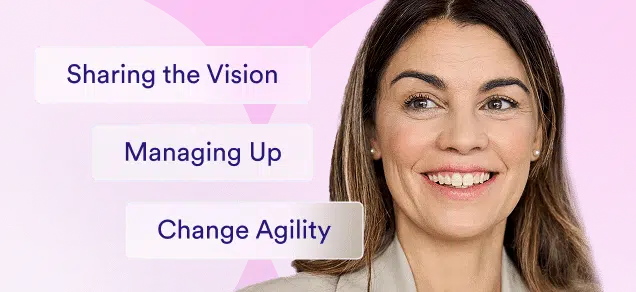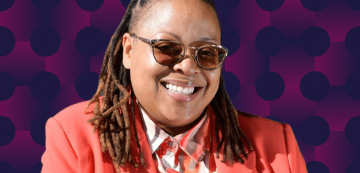Dominique Hollins: Welcome leaders. If you are in this session today, you are either leading organizations, whether it is projects or teams. Maybe you are facilitating the training and development for your organization. Whatever your role in your company you are here today to discuss or to learn about how do you lead change through powerful communication.
Especially during a time right now, this is one skill of over 50 skills that we offer here at home across more than a hundred classes, so I'm glad that you chose to be here today. This class has been augmented for your experience today, and it's gonna be a little different than the way we normally host our typical classes.
And let me take a pause and introduce myself as Dominique Collins. My pronouns are she, they, and I'll give a little more of an introduction in just a moment. Today's class is gonna be about 40 minutes of instruction, and we're gonna leave some time at the end for you to ask q and a. About the experience that we're all gonna share together.
So I encourage you if you [00:01:00] have questions that come to mind about what it looks like to integrate home, what this experience looks like for your teams or for your organization, anything of that nature, feel free to put it in the q and a section. And then my colleague Anu, at Hone, hone Anu, if you feel free to wave to the wonderful people, ANU is here.
She's gonna be taking a look at q and a. She also has a message for you all later on today. And if you have questions or things that you need, you can also reach out to ANU as we get started. All right. I also remind you to take notes based on what you hear. How could this class be used for people, leaders in your organization right now?
What are some functional changes that you are, or operational organizational changes that you might need, this communication channel or this skill for, for the leaders at your company? So with that context, I wanna go into the conversation and start with leading change through powerful communication. My name is Dominique Collins.
As I mentioned earlier, not only am I a coach and a facilitator here with the [00:02:00] home platform, but I'm also a diversity, equity, inclusion, and accessibility practitioner. I work with leaders all over the world looking at the relationship between folks, and that plays a huge role and communicating change management.
This comes from about two decades of operations, business analytics, working across businesses and both. Financial services and in the tech industry. So where it is relevant, I'll bring those insights. In addition to some information about psychology and consciousness were relevant from my graduate studies, so that's why I am here and supporting you all today.
What I would love to glean from all of you and the container that we've created for your participation comes through these house agreements. We would love for everyone here to keep your video on where possible, whether it's relevant. I recognize this is a webinar format, so I won't be able to see your video.
But for those of you, if you are able to see each other in a, a, use a typical home class, we encourage you to keep your video on. But I can see the names of the folks who are coming in. We would love for you to be [00:03:00] active participants, so there will be a number of opportunities for you to type into the chat.
There are more than 70 people in this room right now, and there are others who are expected to come, so we're gonna try to manage for that volume of folks here. I'm gonna encourage you to try to step outside of your comfort zone and lean in to any discomfort you may sense during this discussion so we can more authentically address what that may mean and explore to get together in today's session.
I encourage you to treat others with respect. We're coming from different lived experiences and we wanna make sure that we're all respecting those differences in this conversation, and that you also uphold confidentiality, that you share your experiences without revealing the names of individuals or organizations while sharing your insights.
So it is my hope that if you can use the, you can also use the reactions as well to identify your receptivity. So please type into the chat if these agreements work for you. Let me know if this resonates right, and if you have any adjustments or accommodations. Please feel free to reach [00:04:00] out to a new at home and then she'll work to support you.
Thank you so much, Kiki. Alright, here's our agenda for today. We're gonna discuss four elements for effective change communication. We want you to be targeted on what those elements are so that you can actually practice them immediately following today's session. Then we're gonna talk about how you communicate around change in a way that is both transparent and also compelling so that you are more effective at bringing people along with you.
And then lastly. How are you going to work to ensure that your change communication is an ongoing conversation? It's well beyond that initial announcement, but it's how you maintain that momentum throughout, and we'll talk about that today. Now, let's start here. Let's say for example, that you and your team work in an office, and you always come in as a team and work on the first floor.
But one day when you come into the office on the first floor, [00:05:00] the manager or the leader for the team says, we are now all moving to the 10th floor, and we have to do that within a certain period of time. What are the steps that you're gonna take to initiate this change? I'd love for you to type into the chat so we can get an idea of where would you start, what needs to happen for this to be successful?
And I will hop into the chat and see what kind of answers that you all share.
Explain why the change is being made. Thank you. Cynthia Davis is ask why, right? Get us the why. Communicate the why. Excellent. Looks like you all have taken some of our other change courses as well. How does it affect change? Ev, ev everyone. Absolutely right. We have. Why is the change happening? Give us a plan.
Thank you, Leanne. What is changing, right? What are the details here? What does it take for us to get from the first floor to the 10th floor? Dawn says, what does the 10th floor look like Before we go there, can, can someone let us know what are we working with? Thank you so much, Dawn. So [00:06:00] as you all can tell from the insights that you all shared.
There's a lot of information. It needs to be both communicated clearly and being understood and adopted by the very people you are expecting to facilitate this change, and as many of you just identified, that's where sometimes change commun communication stops. It is not just getting folks to understand what change looks like by that initial announcement.
Here's a di, here's a vision for you and how to transform that vision for our team. What people often miss is what comes next, and that is how are you gathering that feedback from the very people that you expect to facilitate that change? What are the methods that you are using? How well do you understand and incorporate that feedback when they communicate with you, they are telling you what to look out for and why that change may or may not allow for their adoption.
So this is key and we often miss that. In [00:07:00] addition to that piece, you are also missing and, and sometimes what is the roadmap to get there? How are we checking in on those milestones and how are we communicating the quality of our success? Do we need to pivot? These are some of the steps that we often miss when we are communicating change, and the truth is, the goal is to not only communicate that information, but to make sure that it is understood and that you can sustain it.
So that leads us to the overall assessment and view of what the critical change process looks like. There are a number of steps, and as we just saw, there's so many things we have to communicate that we wanna be clear that you all are able to both understand this process and that you're confident to lead it.
Successful change involves several steps. So much so that we actually have four classes dedicated to walking through change, communicating, change, implementing change, et cetera, and there's more information on the on [00:08:00] the site to provide that context. That includes informing people about the change, helping them to get on board, making sure that they actually have what they need to execute, both in time and resources.
Also creating a plan or roadmap for them to see that while having clear milestones that you check in on throughout the process. And then once the project or the change has been implemented. How do you do a look back and assess what went well and celebrate those wins, and also learn from those areas of development?
Given the complexity of this process, what we're going to do today is focus on the main two. We're gonna talk about the effectiveness of how you communicate and inform people about that change, and then lead into the portion that gets them on board to actually adopt that change and be committed throughout the process.
So now I invite your input. What do you think the goal of change communication communication is? [00:09:00] What is the goal of change communication? I'd love for you to type into the chat. Let's see what kind of responses that we get.
Hmm. Give you all a moment to tie enforcing compliance, right? Oh my gosh. Sometimes Joshua, yes, it could be enforcing compliance. 'cause everyone has to get on board, inform and clarify to adopt and champion the change. Rachel says alignment and clarity bring people along with the process, right? I'm seeing alignment.
Alignment, alignment. We have to communicate. We're doing it for a reason. Paloma says, we also need to get buy-in. You can be aligned, but what if you're not bought in? Jessica says, inform the team of the change to get everyone on board. These are all much better answers. There is no better. Joshua, they're actually.
Are more goals than sometimes we all recognize. Yes, Beth, transparency and alignment. What you all are witnessing now is that communicating change is actually [00:10:00] a complex or can be complex because there are actually so many goals that must be achieved in one message that may have to be translated in a number of different ways for various members of your team.
Let's take us back to change communication goals, many of which you all just mentioned. So I want you to consider this metaphor or this analogy when you think about change communication goals, it is like trying to get people on board a boat or a ship while it is moving through rough waters. When you are trying to do that, here are the things you need to be able to do.
Inform. That's step number one. One of the main goals that many of you mentioned. It's reducing that uncertainty by providing the relevant information at each stage so folks can adopt it and process it. What that looks like in this analogy is where's this boat going? Why is this boat going there and what's in it for me?
Right. The WFA that we all may always talk about. Right. So when you're talking about [00:11:00] the inform, you're trying to get people on this boat while they're seeing the waters of Rocky, how do you reduce that uncertainty or provide relevant information where they may not have visibility? The second goal is to inspire.
In order to get that buy-in, you have to motivate the stakeholders to embrace the change. If it is a company-wide change, the stakeholders are everyone. That's gonna be very different for the marketing team than product development, than finance, than sales, then customer success. And so you want to make sure that you not only identify all the key stakeholders, but that they embrace the change.
What that looks like is, why should I get on board this ship with those waters? You wanna inspire them to do now, the next two steps, understanding is also your responsibility. You must understand and recognize that their reactions are going to be divi different for each person. Your responsibility to understand those reactions, to listen and comprehend as you [00:12:00] prepared for change, what that looks like is what's gonna happen if I get on that boat?
Why am I getting on that boat right now? You and then here are the, here's what I need to get on that boat. The more you understand their perspective and their feedback, the better prepared you are to lead them through what happens next, and then their sustainability. If you want to maintain that mo momentum and that support for that change over time, you have to continue to talk about these goals.
What is that roadmap? Where are those checkpoints? If you're on the sea, in our rocky waters, when are we gonna stop at land? When are we gonna refuel? When are we gonna check in to see where we are on the map? The analogy here is if you want people to get on board this boat, you wanna make sure you inform them, inspire, understand, and sustain.
So what we're gonna do for the rest of class is that we're also, we're gonna walk through informing and inspiring people. That'll be the earlier part of class, so we can really deepen what that means for us. And then the next part of the [00:13:00] class is the understanding portion, how you prepare yourself to receive that feedback, and then also how you're sustaining that momentum throughout the process.
So here's where I'd love to get some feedback and some engagement from all of you. Based on the four goals we just outlined, which of the change communication goals did you find most challenging and why? I want you to consider a major change that you have led or are a part of, or been a part of, which of these change areas were most challenging and why?
Feel free to type into the chat. I'd love to hear. Where and why, and as you, as you answer them, I'd love if you can also add a why This allows the 83 of us who are in this room to see globally look at all the different responses you're getting from folks because maybe you're more connected and you're having experiences that are more similar than you, than you may understand.
Right. Thank you, Julie. Right. It's the understanding [00:14:00] part because it includes resistance to the change, right? That that requires a level of emotional intelligence and empathy. Putting yourself in the place of folks who will have to adopt that change. Thank you so much. We have folks that are saying, understand and sustain, right?
Like I'm hearing a lot of folks might be challenged with the understanding part. Here's the thing, if it helps, if you are challenged by the understanding part, put yourself in their shoes. Right. What is it like to be them in that moment? While you may be facilitating the change, they're still human beings, and so what does it look like to be in their shoes emotionally?
So just a, just a, a best practice or a tip for you to consider. Also, we have the inspire piece, right? You have to now convince people why they should get on board this. And finding ways to speak to that stakeholder in ways that are meaningful to them in the context of what success looks like, what their goals are, what's important to them.
Thank [00:15:00] you so much, Tammy says, to sustain, right? Once you've made this announcement and gotten everybody on board in your execution, how are we maintaining this mo momentum through the completion of the project? Thank you, Tammy. Right? Inspires the same. So what we're gonna do today. Is offer you some strategies that would allow you to understand what can I do to inform more effectively, to inspire with more impact, to understand the many different lenses of the stakeholders involved, and then how you can sustain and maintain that momentum.
So now. I am going to place into the chat for all of you. For each of our Hone classes, we have learner guides that typically accompany each class unless you're in a discussion class, which this is not today.
So the first thing we're gonna talk about is how to actually inform people. And we wanna be as transparent as possible given. Then not [00:16:00] only is it possible that you yourself may not have enough information, but also you might not even like the change.
We don't want to communicate that. We wanna be very clear about the what to the best of our ability and the why. Here's what that looks like. First, what you wanna do is make sure that you can offset three different types of uncertainty. The first is strategic uncertainty, and many of you identified this in our discussion earlier today.
How are you communicating the why? When we look at this through a business lens, what is the key reason why as an organization are even making this decision? What are the key outcomes for those decisions? If you are able to clearly determine what the strategic idea is and the why, it will help to eliminate some of their uncertainty.
And McKinsey research has found that if you can do this effectively, you then increase the likelihood of the probability of your change success rate by three times. [00:17:00] So we wanna make sure by the magnitude of three x, we wanna make sure first that you have strategic certainty. And here's the thing, folks, as I mentioned, even if you don't know the Y, you wanna be clear on saying, if I, I don't know that yet, but I can follow up and get back to you.
The second is the implementation uncertainty that you want to help to reduce, which is what is the plan. What is the roadmap? You wanna make sure that you can articulate where the organization is or from where that change is coming, that you can articulate where you all are headed. Again, back to our boat analogy, you want to eliminate whatever that un un, that uncertainty is because the waters are still rocky and there's change that's happening in that process.
So you wanna be clear about communicating that message as well. The last one is we wanna be sure to alleviate job related uncertainty. And by that we mean people's job security, the workload and their actual capacity. And then are [00:18:00] their roles changing? Now, this is the area where most leaders hesitate and choose to either avoid or they rush through it.
But in fact, this is the area where you wanna spend the most time. Whether your teams or your, or whether the members on your teams communicate this or not, in the back of their mind, they're thinking again about what's in it for me? What does this mean to my job? What does this mean to my day to day, and what does this mean in terms of the longevity on my team?
If you can address all three of these points within the informed objective or the informed goal, then you are that much more likely to drive the willingness for this to be successful, but also to help to facilitate the adoption. The goal at the informed stage is to offer transparency. Honesty and what, what we don't write down is the authenticity with which you do that, but I'm gonna offer that too.
So I'm gonna give you an individual reflection to consider. Take a look at your [00:19:00] learner guide and meet me at slide seven. You're gonna have the option to click on the different toggles to evaluate or rate how you feel about these three areas of uncertainty. So I want you to do this. Consider a time where you personally felt resistant to a change on your team.
If you've been working long enough, I'm almost positive you have an example now in your learner guide on page seven, on the right hand side of the slide, I want you to rate the extent to which the person who communicated this change to you addressed each of those areas of certainty.
Nice. Abigail. A little higher on the strategic, but when it comes to getting the, the work done and giving that security, it's a little shot. Nicole is in agreement. Thank you. Implementation uncertainty always rates lowest for me, right, Patty? Because. We don't know how it's gonna go, but we gotta figure it [00:20:00] out.
There's usually more gaps in the implement and that's why it's so important to get feedback from your teams so that you can get a better understanding, more data to assess what may be the reality or the the change that is to come. Thank you, Patty.
Now, as you go through these individual reflections and you consider yourself in this position. Think about what that means for your teams. Think about what that means for some of your strategic partners or your stakeholders. Are you the only one experiencing this? Do you think others feel this way too?
That's why it's so important that we're aware of these processes so we can put ourselves in their, in their shoes and try to be both in the situation, but also try to lead and manage it at the same time. Continuing on. The next step is you must inspire folks to come on board, but the only way to inspire them effectively is that you have to connect sources of meaning that are [00:21:00] personal to each stakeholder group, and that looks and sounds different depending on who you're talking to.
Then you need to also communicate. How will that meaning be served or preserved in the process? Now, you may be familiar with organizations, they make changes and one of the number one things they say, or one of the number one reasons is shareholder growth. Business in the bottom line, right? That's why we are here.
It makes sense that that's the case, but the truth is not everyone is inspired by that. That's just business as usual. How do we communicate these things for each stakeholder group? That's important. So I'd love for you to type into the chat beyond the business reason. What are some other inspiring messages that will help folks to implement the change?
What are some things you would wanna hear? Hmm. Brian says, I aspire to inspire, but I focus on intrinsic motivators. Thank you for that vulnerability, Brian. There are a lot of folks who are just like that, some of [00:22:00] which is because they themselves have either been trained that way. That's how they were in school.
Maybe that's the nature of the business. There are, maybe it's their personality, but I appreciate the willingness to shift. Hopefully this presents some ideas of why it's important to look at reasons beyond those intrinsic motivators, right? What about others? Please feel free to type into the chat. What sources of inspiration or what else would you might want to hear as a reason for change beyond the bottom line?
What would inspire you? Opportunities for personal growth. Absolutely. Right. Company stays competitive, so job security increases. Thank you, ADA, and thank you Julie. Right. Will this change make my job easier, right? New systems to make the workload smoother. Thank you, Patty. Right. What about my job on the day to day?
Excellent. Each of these are key. Here's some other things that we're suggesting. What is the mission for [00:23:00] the company? How does it align to the company that you signed up to join and how does it impact and affect society? What about its meaning to the company and overall shareholders? What about the impact to different functions in the business, different teams, whether they be remote, whether they are in the different locations around the world?
If you're a global company, what does that look like for those teams and how does it change their daily experience? What's the impact to self, the individuals? How do you speak to them like people? And then lastly, how are your customers going to be impacted by this shift? Right? Abigail adds innovation.
Tell me how our product makes is better for customers and perfect timing, Abigail, right? As I'm talking about why it's important to talk about customers, when you address these five areas of work research, research has shown that addressing all of them specific to the language for each group increases the likelihood of [00:24:00] adoption.
So you wanna inspire the executives in a way that inspires executives, the marketing team, in a way that inspires marketing. The those on the front lines. Each role, each perspective has a different way that this message needs to be communicated. Here's an example. Robert Lee is the CEO and founder of Dragos.
And during a major shift for that organization, here are the different messages that they drafted who address each audience. I want you to take a look at each one. Feel free to highlight which of these areas resonate with you, or which of these did you do you struggle with, or do you prefer in the chat?
Feel free to identify the area and any thoughts that resonate with you.
Sustainable helping the Earth people, society, not just profit. Right. Sustainability is, it's huge right now, but it's been huge for, for some, for quite a long time. Thank you. Maybe be able to focus on the ease of disability, right?
I talk about accessibility [00:25:00] all the time and what that means for folks. People wanna hear this. Thank you so much. Kathleen. Adds team and experiences. Triple bottom line, right? Excellent. Right. Triples the, are you saying that when you focus on team and experiences, that it does triple the bottom line?
Kathleen,
The key here. Is to use messaging that lands for the audience intended to receive it. Right? Focus on more than just finances, but our people, our communities, and our planet. Excellent. Thank you so much, Kathleen. Right. Notice how what's important to some is different than what it may be for others. The goal is to be mindful of who your stakeholders are and what is the language that you need to speak that resonates with them, that will help get them inspired and on board.
Okay, now we're back to our individual reflection, and I want you to meet me on slide nine. Consider a ti that time that you felt earlier where you felt resistance to change on your team. Let's go back to that moment [00:26:00] now, which sources of meaning were most threatened by that change? And this is for you.
Consider that time earlier where you felt resistance to a change on your team, which of these sources of meaning were most threatened? That's usually your hint that that was the trigger that caused your reaction. And then the second thing to consider is to what extent were these sources of meaning actually addressed in the communication?
So either A, they did address it and maybe you didn't like it or it didn't resonate with how, how you would like for it to work, or B, they didn't address it at all, which can even be more anxiety driving. Right? And maybe there's some other scenarios, but I'd love for y'all to take a moment to fill it out and feel free to type into the chat any insights that come up for you.
This is why the role of the people leader is so important. Oftentimes when change happens at the executive level. At the team level, that that bridge may not [00:27:00] be built. The people manager of that team is usually the bridge. So the better able, they are prepared to take that communication from the top down and then to be a bridge for their teams to help translate that.
That can impact team experience. So thank you for highlighting that. Right. If there's anyone else who wants to share, again, you may raise your hand and then we'll unmute so you can share, because now is discussion time. I'd love to learn from each of you so far. What did you learn from your reflections?
And you can refer to this one or the reflection we did earlier with your communication goals and which one was more challenging, but what were your key takeaways, and also how might you apply what you've learned so far to your future change communication efforts? Julie says, team experience. I feel like my team was disproportionately impacted while other teams were able to keep doing what they were already doing. I'm so sorry you had that [00:28:00] experience, Julie, and sometimes that absolutely happens.
It either is the nature of the business, or sometimes people were not as considerate as they could have been in the design. That is a reality for some teams. Daniella adds the change wasn't fully executed and we are left dealing with the mess. Mm. That's challenging, right? This is what happens when all stakeholders are not considered. Patty writes in past roles when I was customer facing. Those employees get hit the most. Yes, and don't always have the power to make decisions.
So I would say self hit hardest. Thank you, Patty. That's huge too. Their customer facing, they probably have the most insight into the most important stakeholder of all. The customers and then that rotation, right, can be very difficult. So thank you for sharing that. Julie shares, I think that this resistance did not occur in a vacuum.
It was part of a, a bad culture and threatening context, right? These are indicators [00:29:00] too. Should I stay at this organization if this is how they manage, change and treat their people? Should I stay right? That directly impacts retention and attrition. Change was communicated, but no one worked in reality to make it happen. Right. This is key, Paloma, because we talked about the four goals of change communication and some of the errors that people make, and it's that they communicated it, but what was the follow through? The company assumed it would just happen overnight.
Instead of considering a transitional period to actually get there. Right. Nicole? Seconds that I've seen this before, I actually facilitated a change class earlier. We talk about this all the time. What are those? What are those steps or stages in the process? And what we're finding is that there are a number of folks who are not well versed in the entire change process.
And so we have gaps like what Paloma has highlighted here.
When you do your initial research, and first of all I'm gonna answer, but if anyone [00:30:00] else has have thoughts for Samara's questions in the chat, please add them. My, my recommendation is once you do the informing piece, and then also you get that buy-in when you get that feedback, that is more data.
That's gonna let you know what is the frequency that you should engage. Depending on the scope of the project, you may have more frequency in the earlier stages of the change process and as the roadmap is developed, that may spread out. That could be a weekly standing meeting or it could turn to biweekly.
Monthly or quarterly, depending on again, the nature of the change. So your investigation and all the research that you do once you communicate it and the feedback you get from your team, it's an iterative process until you identify the roadmap and then that will dictate here is where we need to communicate and how frequently throughout this process.
I hope that was helpful, and if anyone else has recommendations for seminar, we'd love for you to share that. Daniella types into the chat, a lack of training around behavior change that is needed to make [00:31:00] change successful. Correct? Not all change requires training, but all change requires information. So we may wanna make sure there's there.
In week one. You have informed and inspire. This is where you discuss the changes that you communicated with in one-on-ones with your teams, and then you send a full staff email as a follow-up to that communication. Then the second week, you want to lean into the understand portion of the four goals.
This is where you're collecting that feedback, Samar. So this is gonna help to inform how you build that roadmap and building your communication plan. Now in the third week, you are working with your team to create that change implementation plan, which will include checkpoints, milestones, key performance indicators, and the like.
And then between weeks and seven, now we're making sure that we understand you're checking in, do these pain points work, and when it comes to implementing changes and one-on-ones, you're likely gonna get more details about how this is impacting everyone. And then when you get to week eight, this is, now you're [00:32:00] in a two month, you, you're in about a two month timeframe, right?
And again, this is dependent upon the nature of the change. Change can happen quickly, or change can happen over a period of time, but the more you know, that will dictate whether it's a a eight week process or six month process, or 18 month process, et cetera. In those final stages, the inform and inspire.
You wanna make sure that you're making progress towards those goals and that you're being very visible in team meetings, celebrating the wins, highlighting what did and did not go well. You also will need to determine, do we need to pivot? Based on what we've learned, the more frequently you communicate and keep people engaged, the more likely they are to remain and sustain during the change process.
Right. And, and, and TE is saying, especially on the leadership side, Daniella right, that that lack of training around behavioral change. Correct. Some people are. Promote it into the position of leadership without learning [00:33:00] some of the people skills of leadership. And that becomes apparent when we see some of the processes, skills and courses like what Hone is offering helps to build or bridge the gap in some of those skill sets that folks may not have learned as they were navigating their career trajectory.
So thank you all for highlighting that. Some people just don't know and, and courses like this are an opportunity to help to, to bridge the gap in those skills. So this is an example. Is there anything that stands out to you for this plan? Any feedback or thoughts before we transition?
Tay says, Gallup did a survey. Over 80% don't have a leader or communication skills to be promoted. Yes, that's just I, I've heard about that as well. I think this is a great practical plan. Thank you and Daniela, and you all are welcome to in your Learner guide. Do we have the yes in your learner guide on page 10?
This is available to you. Feel free to save it in the folder so that you can reference this in the future. We also have several other [00:34:00] change management courses where you can tie this into your plan. All right, so we've gone through the instructional piece.
We gave you a taste of what it would be like to experience our home classes, particularly around the areas of change. There's a lot going on around the world right now. We offered you some things to consider and some practical strategies, and now the floor is open. , ANU is gonna give a really nice overview a Anu, take it away.
Anu Patel: Yeah. Thank you. I'm so happy that everyone joined us today. And, you mentioned this a few times. This is similar to a typical home class taught by Coach Dominique, and we've got other coaches that, that do the same and teach the same. And I wanna share how we can help organizations like yours take their people development even further , coach Dominic or shared some ideas.
, But here's what we, at home focus on the challenges you're facing right now, whether it's developing managers, supporting senior leaders. We're helping with performance management and goal setting across the organization. We help with continuous [00:35:00] upskilling also to meet training and development needs.
And what makes us different. We blend the best of both worlds, so best of AI and human led training. You will get live classes with expert coaches like Dominique, where people actually practice skills, get real feedback, and learn together. And with hone ai, your team can build critical skills like feedback, coaching, and delegation.
Practice real world scenarios, get personalized coaching and, a 24 7 co-pilot to help you navigate through development questions whenever you need it. And that's really how we think that learning sticks., And speaking of learning, we're hosting forward our awesome new webinar Next, actually, event very soon.
The next slide, please, Dominique, I forgot to tell you that. Thank you. So it'll be the next slide. Oh yeah. There you go. Perfect. So this event is, happening on September 10th, and it's designed specifically for HR and l and D teams dealing with what you're dealing with, shifting skills and skills [00:36:00] needs.
Performance pressures and figuring out how AI fits into all of this. You'll hear from experts at Lattice, Docebo plaid, Amazon, and others who are going to share real strategies with you, that you can use to drive performance, close the skills gap, and build more agile teams. We'd love you there and we'd love to have you register, and I'll share the links in the chat right now.
So feel free to register. And if you have any questions, of course, reach out to our team anytime. There will also be a survey at the end, so feel free to take, a moment to fill it out. Five questions. And I will be sending the, recording to this event as well as the learner guide very soon. And I just wanna say thank you for joining us and, if there are any questions, please reach out.
Dominique Hollins: So I hope that this landed well for you. I hope you have a fantastic rest of your week. Anu, thank you for joining me , today and I will see you all hopefully in another Hone class.











